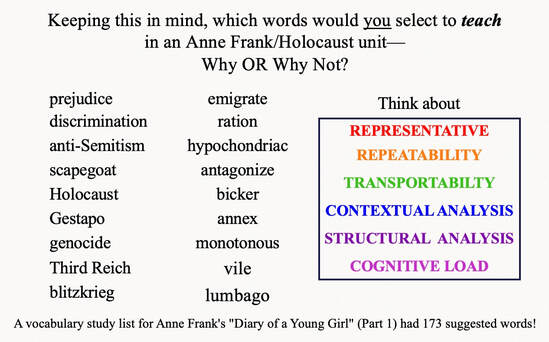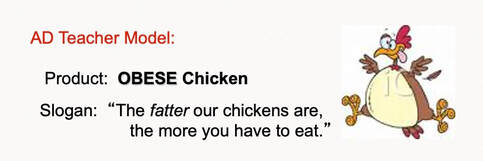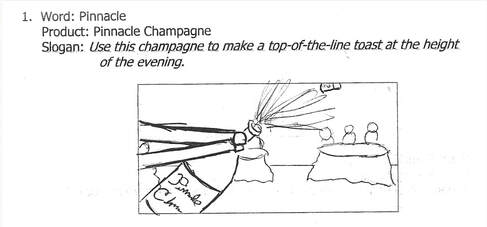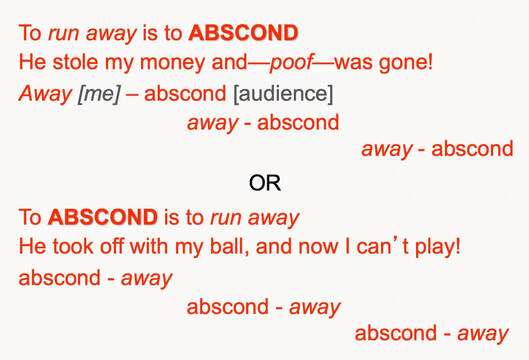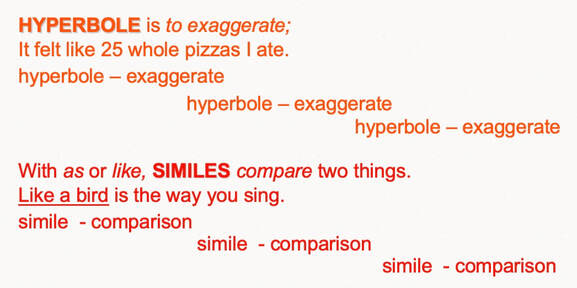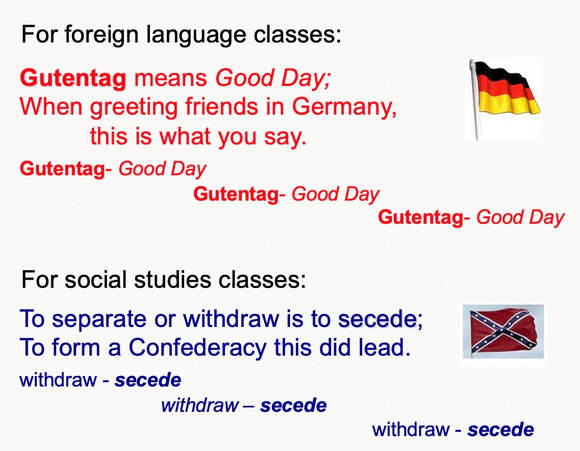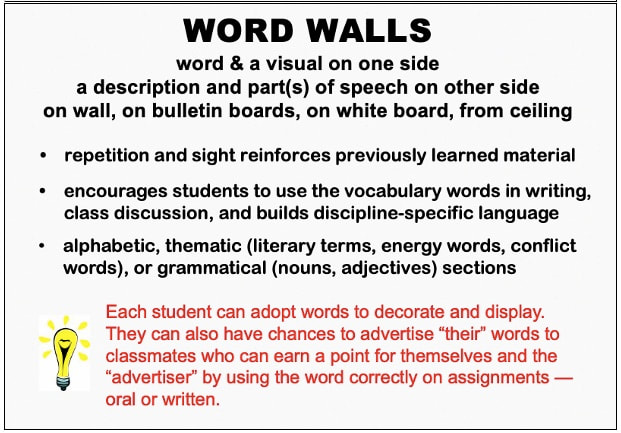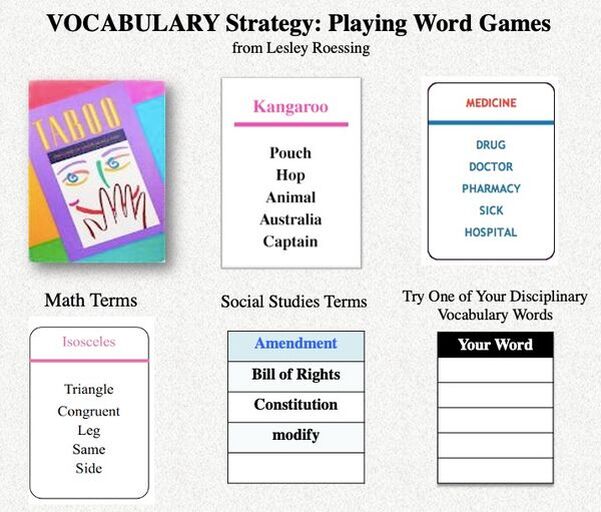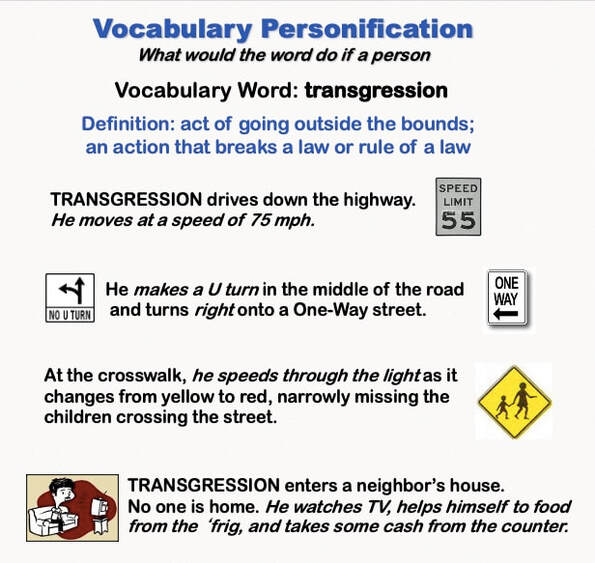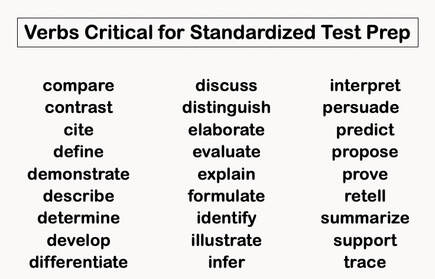- INTRO/SITE CONTENTS
- MY PUBLICATIONS
- BLOG
-
BOOK REVIEWS
- PLANNING A DIVERSE LIBRARY
- Surviving Loss & Abandonment
- Historical Fiction
- Sports Fiction
- Justice & Change Seekers
- Mental Health & Neurodiversity
- Latinx & Hispanic Characters
- Bullying
- Acts of Kindness
- STEM Novels
- Identity & Self-Discovery
- Winter Holidays
- Contending with the Law
- Family Relationships
- Stories of Black History
- Read Across America
- Verse Novels
- Immigrant/Refugee Experience
- Strong Resilient Girls in Literature
- Asian, Asian-American
- Novels featuring Contemporary Jewish Characters
- Multiple Voices & Multiple Perspectives
- Short Readings: Stories, Essays & Memoirs
- Graphic Novels
- Physical Challenges & Illness
- Characters Who are Adopted or in Foster Care
- Love & Friendship
- Memoirs
- STRATEGY SHORTS
11. Why Assigning Students to Write Sentences Does Not Work
The Problem: Students look up definitions of new vocabulary words and write sentences on their own.
1. Multi-meaning words:
In a U.S. History class, word assigned is appeal.
Student looks in the dictionary; one definition is the power or ability to attract, interest, amuse, or stimulate the mind or emotions.
Student writes: Sally and Cal appeal to me by their good looks.
In a U.S. History class, word assigned is appeal.
Student looks in the dictionary; one definition is the power or ability to attract, interest, amuse, or stimulate the mind or emotions.
Student writes: Sally and Cal appeal to me by their good looks.
2. The word is used correctly but sentence doesn't show comprehension of the meaning:
Science class: word is gigantic.
Student Sentence: I was in an accident and made a gigantic dent in the car.
Science class: word is gigantic.
Student Sentence: I was in an accident and made a gigantic dent in the car.
One Solution
1. The teacher gives an explanation of the word and writes a sentence using the word correctly and so that it creates a context or includes an example.
2. The students then write their own shadow sentences that include a different example.
1. The teacher gives an explanation of the word and writes a sentence using the word correctly and so that it creates a context or includes an example.
2. The students then write their own shadow sentences that include a different example.
10. CHOOSING WHICH WORDS TO TEACH
What type of WORDS to Teach?
How to SELECT Words to Teach:
How to SELECT Words NOT to Teach:
- high-frequency-use words that students will encounter in and out of school
- critical academic vocabulary across content domains
- academic vocabulary used in standardized tests (see Vocabulary Strategy #3)
How to SELECT Words to Teach:
- Representation: Words that are representative of families of words students should know for speaking and reading.
- Repeatability: Words that will be repeated in a text or throughout the student’s school year or in their lives outside of school.
- Transportable: Words that can be transported discussions ;to writings; to multiple content areas.
How to SELECT Words NOT to Teach:
- Teach Contextual Analysis for situation where readers can use context clues to determine the meaning of the word without direct instruction.
- Teach Structural Analysis and Morphology so students can determine the meaning of the word without direct instruction (see Vocabulary Strategy #1).
- Do not exceed Cognitive Load so students can actually learn the words studied and integrate in conversations and writing.
Examples of my thinking; your thinking may be different for different reasons:
- prejudice—an important word that students will see and use, possibly in other content areas; however I may have taught the prefix pre, in which case students could figure out the meaning by morphology.
- monotonous—depending on previous morphology study, students could figure it out .
- Holocaust, Gestapo,Third Reich, blitzkrieg—students may not see in any other context (possibly in other content areas) but I would give the explanation, rather than teaching the words.
- emigrate—I would teach the prefix e- as students would be familiar with the terms immigrant and immigration.
- lumbago--rarely will student readers and writers need this word again. I would simply give the definition and an explanation. Also vile and bicker. For those types of words that I don't need to teach in a whole-class text, I would prepare and distribute a Glossary of Terms.
- genocide, antagonize, and hypochondriac would be good terms for morphology study.
- discrimination, scapegoat—I would teach.
9. CREATING LIMERICKS TO REVIEW VOCABULARY
A limerick is a short humorous poem of five lines with the rhyme scheme AABBA and a specific rhythm that follows the rhyme scheme, roughly…
Line 1: la, LA, la, la, LA, la, la, LA (3 stressed beats)
Line 2: la, LA, la, la, LA, la, la, LA (3 stressed beats)
Line 3: la, LA, la, la, LA (2 stressed beats)
Line 4: la, LA, la, la, LA (2 stressed beats)
Line 5: la, LA, la, la, LA, la, la, LA (3 stressed beats)
[Think "Hickory, Dickory, Dock"]
Have students write limericks that illustrate their knowledge of vocabulary words learned this year (review solidifies learning). If the limericks are made into a story (see my model), students are also writing narrative poetry. They can also use their limericks (w/o the words) to quiz each other.
A limerick is a short humorous poem of five lines with the rhyme scheme AABBA and a specific rhythm that follows the rhyme scheme, roughly…
Line 1: la, LA, la, la, LA, la, la, LA (3 stressed beats)
Line 2: la, LA, la, la, LA, la, la, LA (3 stressed beats)
Line 3: la, LA, la, la, LA (2 stressed beats)
Line 4: la, LA, la, la, LA (2 stressed beats)
Line 5: la, LA, la, la, LA, la, la, LA (3 stressed beats)
[Think "Hickory, Dickory, Dock"]
Have students write limericks that illustrate their knowledge of vocabulary words learned this year (review solidifies learning). If the limericks are made into a story (see my model), students are also writing narrative poetry. They can also use their limericks (w/o the words) to quiz each other.
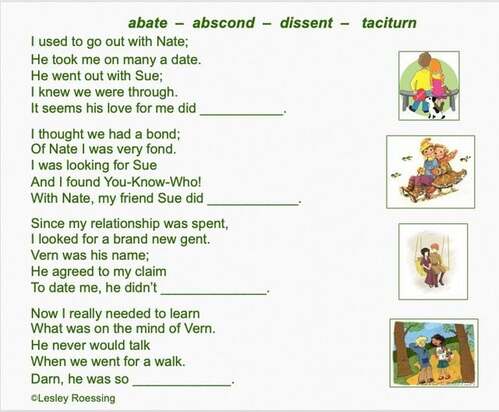
8. CREATING ADS TO SYNTHESIZE WORD LEARNING
The names of some products tell you something about the product, based on the definitions of those words in the name.
Examples:
DIRECTIONS—For each vocabulary word:
1. Choose an appropriate product with which to name it. (It can be an actual product or an invented one)
2. Write a slogan that incorporates the definition of the word.
3. Draw a small copy of the print ad.
The names of some products tell you something about the product, based on the definitions of those words in the name.
Examples:
- Aleve, pain reliever that reduces suffering
- Huggies, diapers that don't leak because they HUG a baby's bottom
- Taboo, game of words that are banned or you can’t say
- Whisk, detergent that quickly takes dirt in a certain direction (out of the fabric)
- Downy, fabric softener that makes clothing soft like down feathers
DIRECTIONS—For each vocabulary word:
1. Choose an appropriate product with which to name it. (It can be an actual product or an invented one)
2. Write a slogan that incorporates the definition of the word.
3. Draw a small copy of the print ad.
7. REVIEWING VOCABULARY THROUGH WRITING RAPS & RHYMES
For each VOCABULARY word, students create a rap:
1st Line is the WORD and the DEFINITION.
2nd Line contains an EXAMPLE. This is the real "test" of understanding.
3rd Line contains REPETITION of the word and definition for antiphonal audience participation.
Rationale based on Research:
There is no principle that is more more effective than RECITATION for transferring material from the short-term memory to long-term memory.
And, the more students do with a word, the more likely they will remember it.
For each VOCABULARY word, students create a rap:
1st Line is the WORD and the DEFINITION.
2nd Line contains an EXAMPLE. This is the real "test" of understanding.
3rd Line contains REPETITION of the word and definition for antiphonal audience participation.
Rationale based on Research:
There is no principle that is more more effective than RECITATION for transferring material from the short-term memory to long-term memory.
And, the more students do with a word, the more likely they will remember it.
In English-Language Arts class students can create raps for LITERARY TERMS, such as those my students wrote:
This strategy can be employed to learn words across the curriculum:
Students can work in pairs to write raps for the words recently studied (my classes did this activity at the end of a month). Each pair then chooses one of the words (out of a bowl) and presents their rap to the class for a review. The class joins in for the antiphonal "chorus."
As a student wrote in a reflection on the activity, "I thought the raps were fun. I enjoyed creating them, and the activity made me really think about the words and what they mean." Another student said, "The rhymes helped me remember the definitions."
My observation:
Rhyme and rhythm, rhythm and rhyme,
Help students remember—every time.
As a student wrote in a reflection on the activity, "I thought the raps were fun. I enjoyed creating them, and the activity made me really think about the words and what they mean." Another student said, "The rhymes helped me remember the definitions."
My observation:
Rhyme and rhythm, rhythm and rhyme,
Help students remember—every time.
6. WORD WALLS
WORD WALLS can be employed in many ways but should be more than just words on walls.
The word is written on one side of cardstock, about 12" x5". A simple picture, or logo, will help learners remember the meaning. The definition and part of speech* can be written on the other side of the card so that, if a student wishes to use the word, they are able to check on its meaning to refresh their learning.
Words can be grouped in sections of the walls or by cardstock color. Words can be grouped thematically or by the novels or the topic or textbook chapters for which they were taught. Words can be grouped by root word or base word and synonyms and antonyms. Or alphabetically. Words can be grouped by part of speech *but that becomes tricky because many words can be used in multiple ways in different sentences
The word is written on one side of cardstock, about 12" x5". A simple picture, or logo, will help learners remember the meaning. The definition and part of speech* can be written on the other side of the card so that, if a student wishes to use the word, they are able to check on its meaning to refresh their learning.
Words can be grouped in sections of the walls or by cardstock color. Words can be grouped thematically or by the novels or the topic or textbook chapters for which they were taught. Words can be grouped by root word or base word and synonyms and antonyms. Or alphabetically. Words can be grouped by part of speech *but that becomes tricky because many words can be used in multiple ways in different sentences
5. PLAYING WORD GAMES
WORDPLAY is an effective vocabulary strategy. One game I find especially engaging and effective for word building is Taboo where the goal is for the player’s teammates to deduce a word from the player’s verbal clues. Players have to explain their words, provide synonyms of the target word or the words on the card which cannot be spoken (the "taboo" words), or give examples of the word for their team to be capable of discovering the answer.
In Language Arts class students can create cards featuring the vocabulary words learned or to be learned; and in content area classes they can create cards for disciplinary terms, adding the five words players would be most likely to associate with the word and are, therefore, taboo. They then can play Vocabulary Taboo, Social Studies Taboo, Science Taboo, Math Taboo, or Health, Art, or Music Taboo. with the cards
WORDPLAY is an effective vocabulary strategy. One game I find especially engaging and effective for word building is Taboo where the goal is for the player’s teammates to deduce a word from the player’s verbal clues. Players have to explain their words, provide synonyms of the target word or the words on the card which cannot be spoken (the "taboo" words), or give examples of the word for their team to be capable of discovering the answer.
In Language Arts class students can create cards featuring the vocabulary words learned or to be learned; and in content area classes they can create cards for disciplinary terms, adding the five words players would be most likely to associate with the word and are, therefore, taboo. They then can play Vocabulary Taboo, Social Studies Taboo, Science Taboo, Math Taboo, or Health, Art, or Music Taboo. with the cards
4. VOCABULARY PERSONIFICATION TO LEARN WORDS IN NEW WAYS
Wordplay engages learners and promotes looking at words in new ways, facilitating the retention of new vocabulary.
Wordplay engages learners and promotes looking at words in new ways, facilitating the retention of new vocabulary.
3. VOCABULARY FOR STANDARDIZED TEST PREP
|
To help students be more successful on standardized tests, a crucial strategy to prepare students for taking these types of tests is to teach words they will encounter on those tests, especially in the directions. Many of these are multiple-definition words that have specific meanings on standardized texts, such as "illustrate," "propose," and "trace."
On the left is a sample list. Depending on grade level and prior knowledge, teachers can teach less or more such vocabulary. |
2. CREATING LOGOS TO LEARN WORDS
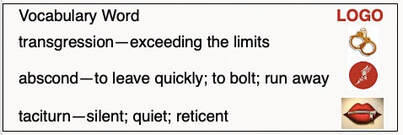
When students are learning a new word, have each draw a LOGO (Image Link) for that word—a simple representation that will let them personally remember what it means. Everyone's logo may be different.
Cognitive research shows that visual is more memorable than verbal. Memory is said to increase by 50% by making a graphic representation.
It is more effective and meaningful when the learner generates the visual representation. I asked volunteers to draw theirs on the white board to give some suggestions.
Cognitive research shows that visual is more memorable than verbal. Memory is said to increase by 50% by making a graphic representation.
It is more effective and meaningful when the learner generates the visual representation. I asked volunteers to draw theirs on the white board to give some suggestions.
1. TEACHING ROOTS & AFFIXES
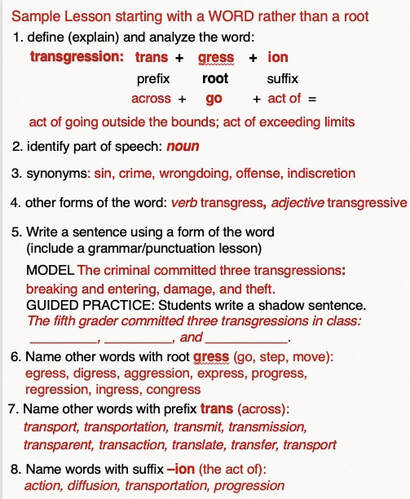
I taught one root a week, and we spent a few minutes each day that week, adding prefixes and suffixes to make new words and then finding synonyms and antonyms for those new words. This also led to a lot of grammar-talk. "Is it a noun?" "Can adding a prefix make it an adjective?" "If we add suffixes, can we use it as a verb? Make it past tense?" "Is it now an adverb?"
Teachers can teach/review a lot of words each week in about 10 minutes a day.
EXAMPLE: ROOT “mit"-> transmit, transmission, transmitted, transmitter, emit, emission, omit, omitted, omission, submit, submission, submissive, commit, committee, remit, permit, permission, admit, admittedly, intermittently,… and all the synonyms and antonyms of these words. And students would come to class with unusual words they found made from the root.
Teachers can also carry the root study across the curriculum, applying to words in math, social studies, and science—even music, art, and health/gym. Some words have different meanings in different disciplines.
It has been estimated that 60% of the English words in common use are made up partly or entirely of affixes or roots derived from Latin and Greek; in science and technology, 90%. Learning roots and affixes gives readers strategies to decipher new words they encounter. I told my students, "Even if I taught you a word a day or 10 words a week, you would never learn all the words you will encounter. But if you learn roots and affixes, you will have the tools to figure out almost any word.”
Teachers can teach/review a lot of words each week in about 10 minutes a day.
EXAMPLE: ROOT “mit"-> transmit, transmission, transmitted, transmitter, emit, emission, omit, omitted, omission, submit, submission, submissive, commit, committee, remit, permit, permission, admit, admittedly, intermittently,… and all the synonyms and antonyms of these words. And students would come to class with unusual words they found made from the root.
Teachers can also carry the root study across the curriculum, applying to words in math, social studies, and science—even music, art, and health/gym. Some words have different meanings in different disciplines.
It has been estimated that 60% of the English words in common use are made up partly or entirely of affixes or roots derived from Latin and Greek; in science and technology, 90%. Learning roots and affixes gives readers strategies to decipher new words they encounter. I told my students, "Even if I taught you a word a day or 10 words a week, you would never learn all the words you will encounter. But if you learn roots and affixes, you will have the tools to figure out almost any word.”
Proudly powered by Weebly


